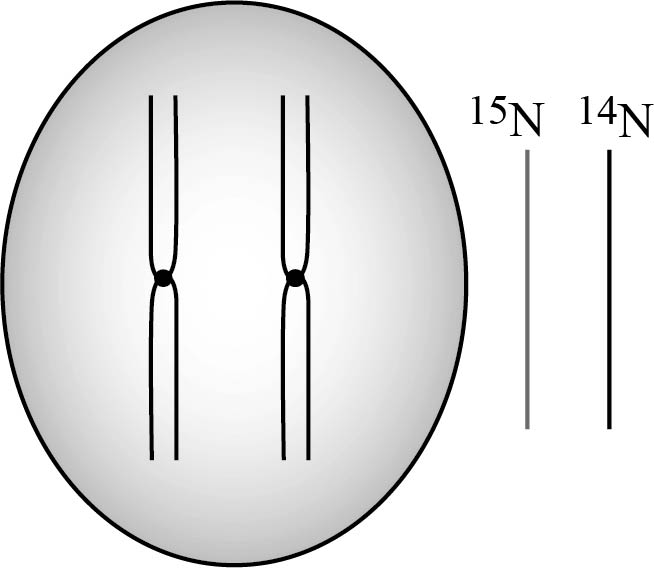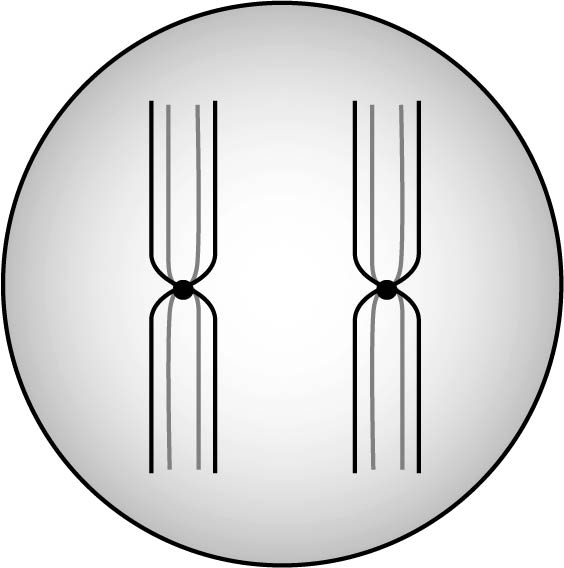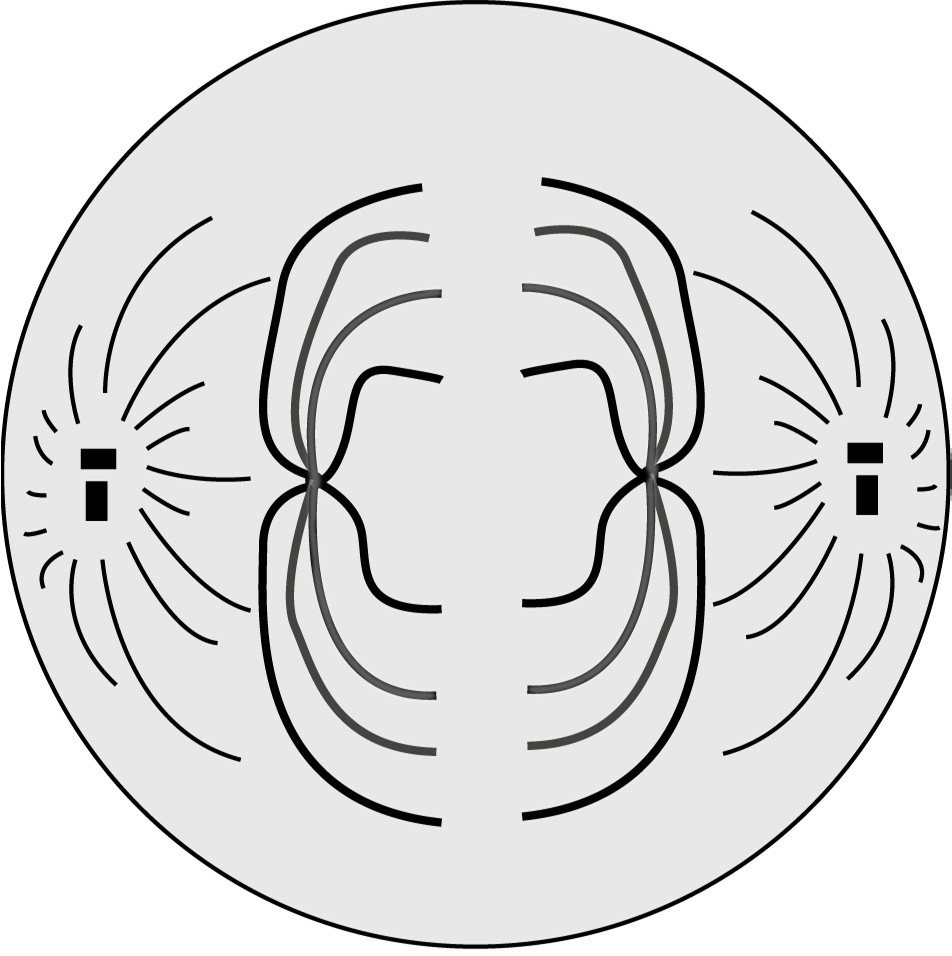
a.
To determine:
Cells in G1, before switching to medium with 14N.
a.
Explanation of Solution
Pictorial representation: fig 1: Pair of homologous chromosomes in a mouse cell.

Fig 1: Pair of homologous chromosomes in a mouse cell.
A mouse which has been grown in a
As in, new DNA molecules that are being replicated as the cell takes place division, only the heavier nitrogen isotope is present to incorporate in it. Thus, the cells which are growing continuously in a
b.
To determine:
Cells in G2, after switching to medium with 14N.
b.
Explanation of Solution
Pictorial representation: fig 2: Pair of homologous chromosomes in a mouse cell in

Fig 2: Pair of homologous chromosomes in a mouse cell in
After continuing to medium rich in
c.
To determine:
Cells in anaphase of mitosis, after switching to medium with 14N.
c.
Explanation of Solution
Pictorial representation: fig 3: Pair of homologous chromosomes in a mouse cell in

Fig 3: Pair of homologous chromosomes in a mouse cell in
If the cell enters into next phase after S phase in the cell cycle, it does not influenced by the surrounding medium. Thus, after the S phase of the cell cycle, the DNA composition is remained same until the next S phase. Therefore, pair of homologous chromosomes in a mouse cell in
d.
To determine:
Cells in metaphase I of meiosis, after switching to medium with 14N.
d.
Explanation of Solution
Pictorial representation: fig 3: Pair of homologous chromosomes in a mouse cell in

Fig 3: Pair of homologous chromosomes in a mouse cell in
Since, after the S phase of the cell cycle, the DNA composition is remained same until the next S phase. Therefore, pair of homologous chromosomes in a mouse cell in
e.
To determine:
Cells in anaphase II of meiosis, after switching to medium with 14N.
e.
Explanation of Solution
Pictorial representation: fig 3: Pair of homologous chromosomes in a mouse cell in

Fig 3: Pair of homologous chromosomes in a mouse cell in
Since, after the S phase of the cell cycle, the DNA composition is remained same until the next S phase. Thus, Pair of homologous chromosomes in a mouse cell in
Nitrogen is a basic component which can produce the nucleotides of DNA and RNA, and given in the mouse cell medium which have
Want to see more full solutions like this?
Chapter 12 Solutions
Genetics:conceptual Appr.-package
 Human Anatomy & Physiology (11th Edition)BiologyISBN:9780134580999Author:Elaine N. Marieb, Katja N. HoehnPublisher:PEARSON
Human Anatomy & Physiology (11th Edition)BiologyISBN:9780134580999Author:Elaine N. Marieb, Katja N. HoehnPublisher:PEARSON Biology 2eBiologyISBN:9781947172517Author:Matthew Douglas, Jung Choi, Mary Ann ClarkPublisher:OpenStax
Biology 2eBiologyISBN:9781947172517Author:Matthew Douglas, Jung Choi, Mary Ann ClarkPublisher:OpenStax Anatomy & PhysiologyBiologyISBN:9781259398629Author:McKinley, Michael P., O'loughlin, Valerie Dean, Bidle, Theresa StouterPublisher:Mcgraw Hill Education,
Anatomy & PhysiologyBiologyISBN:9781259398629Author:McKinley, Michael P., O'loughlin, Valerie Dean, Bidle, Theresa StouterPublisher:Mcgraw Hill Education, Molecular Biology of the Cell (Sixth Edition)BiologyISBN:9780815344322Author:Bruce Alberts, Alexander D. Johnson, Julian Lewis, David Morgan, Martin Raff, Keith Roberts, Peter WalterPublisher:W. W. Norton & Company
Molecular Biology of the Cell (Sixth Edition)BiologyISBN:9780815344322Author:Bruce Alberts, Alexander D. Johnson, Julian Lewis, David Morgan, Martin Raff, Keith Roberts, Peter WalterPublisher:W. W. Norton & Company Laboratory Manual For Human Anatomy & PhysiologyBiologyISBN:9781260159363Author:Martin, Terry R., Prentice-craver, CynthiaPublisher:McGraw-Hill Publishing Co.
Laboratory Manual For Human Anatomy & PhysiologyBiologyISBN:9781260159363Author:Martin, Terry R., Prentice-craver, CynthiaPublisher:McGraw-Hill Publishing Co. Inquiry Into Life (16th Edition)BiologyISBN:9781260231700Author:Sylvia S. Mader, Michael WindelspechtPublisher:McGraw Hill Education
Inquiry Into Life (16th Edition)BiologyISBN:9781260231700Author:Sylvia S. Mader, Michael WindelspechtPublisher:McGraw Hill Education





